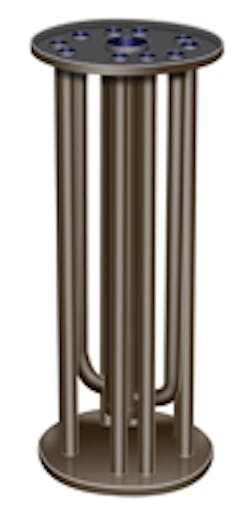MONTGOMERY, ALA. — Rheem Water Heaters has released a new commercial water heater under the Rheem-Ruud name with some interesting features in terms of the heat exchanger design and controls. The SpiderFire line of condensing-type commercial water heaters, so named because of the shape of the heat exchanger, offers six Btuh inputs and high recovery rates, all with thermal efficiencies from 92% to 95%.
The highest capacity unit in the series, with an input of 350,000 Btuh, can deliver 460-gal. of water per hour at a 100°F rise. Lower-input models of 130,000, 160,000, 199,000, 250,000, and 300,000 Btuh are also available.
The high input water heater is designed to deliver substantial amounts of hot water to meet the needs of larger commercial applications, such as restaurants, office buildings, schools, retail stores, and the like.
The manufacturer had the water heater extensively tested by a third-party agency for water conditions and temperature, corrosive environments, dust and lint, increased cycling and venting configurations, as well as thermal efficiency, according to Chuck Rohde, wholesale market manager.
Manufactured in Rheem’s factory here, all six SpiderFire units come equipped with a 100-gal. storage tank and can operate on either natural gas or LP. All models can be installed as a single-pipe, power-vented product, or as a two-pipe, power direct-vented product — the latter for environments where negative air pressure or indoor air quality is a concern. All inputs are available with ASME certification.
The water heaters feature a patented heat-exchange system composed of a series of connected, elongated tubes immersed in the water tank and through which heat is transferred to the water by gases from the combustion process. These multiple vertical pipe runs are what give the unit its design, as well as its name.
Generated by the burner at the top of the unit, combustion gases are blown down through the large main flue in the center of the unit. They must then traverse nearly the full length of the unit two more times, up another set of tubes and then down again through a third set, as the system works to extract as much heat energy as possible. By the end of this cycle, the temperature of the flue gases will have dropped to between 110°F and 140°F, or cool enough for condensation to begin. (In contrast, flue gases in an 80%-efficient commercial water heater typically cool to around 420°F to 450°F.)
This condensing process also has spurred several other design innovations, starting with corrosion-protection. The flue condensate is highly acidic and therefore potentially corrosive. To extend the life of the flue system, the manufacturer has coated the tubes with a specially formulated porcelain enamel that resists corrosion. The large flue network of the water heater eliminates “hot spots,” points in the flue design where hot gases could concentrate, damaging the system over time and perhaps causing premature failure. The porcelain-coated contours of the heat transfer system are engineered to avoid such problems and maintain a more uniform temperature across the entire network. The goal is a more durable product that will better withstand the test of time, even in heavy-commercial applications.
Rheem engineered a “wet base” approach for the lower portion of its flue system, suspending the first two legs of the flue network in water, rather than connecting them to the bottom of the tank.
“Potential hot spots and premature metal fatigue are eliminated,” said Product Manager Ron Johnson. “In addition, this design also boosts efficiency because heat is not lost through the bottom of the tank, as would be the case with a dry base design.”
The design goal was to create a more durable product that will better withstand the test of time, even in heavy-commercial applications.
The cool temperatures of the flue gases permit venting through PVC or CPVC tubing, rather than large-diameter, metal B-vent. When working with the three smallest models in the line, an installer can use 2-in. plastic pipe, as well as 3-in. or 4-in.
“With plastic, the contractor can install the product virtually anywhere, using almost any piping configuration he finds workable,” said Johnson.
The water heater is controlled via the Advanced System SentinelDiagnostic System, enabling installers and service technicians to monitor key functions and components. An LCD, positioned at eye level at the top of the unit, offers easy-to-read status reports on water heater operations. The LCD’s memory includes a scrollable, operational history to detail usage patterns and facilitate troubleshooting.
The water heaters also feature multiple water inlets and outlets, two pairs of hot- and cold-water connections on either side of the water heater jacket that provide installation flexibility, especially in difficult retrofit installations. The units measure 26.25-in. in diameter, smaller than most others in the category, so they will fit more easily into tight commercial spaces. They include a full-flow, factory-installed brass drain valve; direct spark-to-flame ignition system, and a standard three-year limited warranty that can be upgraded to five years.
About the Author
Robert P. Mader
Bob Mader is the Editorial Director for Penton's mechanical systems brands, including CONTRACTOR magazine, Contracting Business and HPAC Engineering, all of which are part of Penton’s Energy and Buildings Group. He has been with CONTRACTOR since 1984 and with Penton since 2001. His passions are helping contractors improve their businesses, saving energy and the issue of safeguarding our drinking water. He is a graduate of the University of Notre Dame with an A.B. in American Studies with a Communications Concentration.
